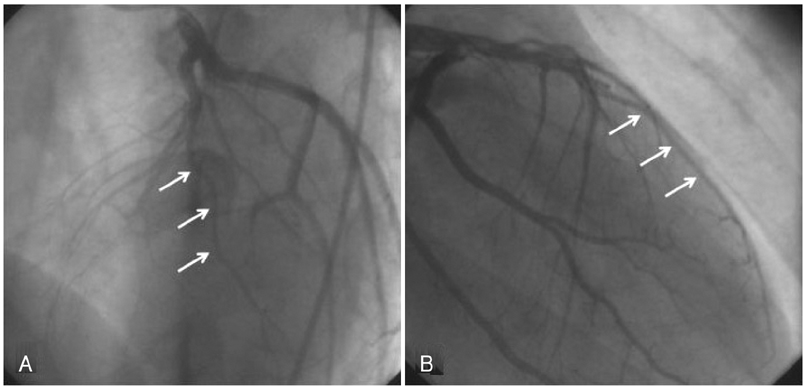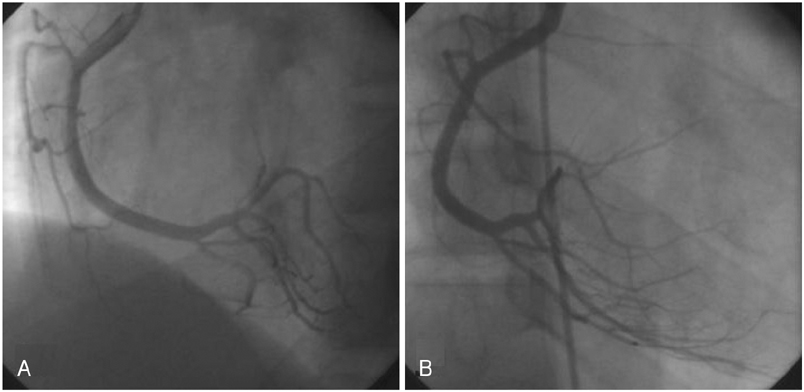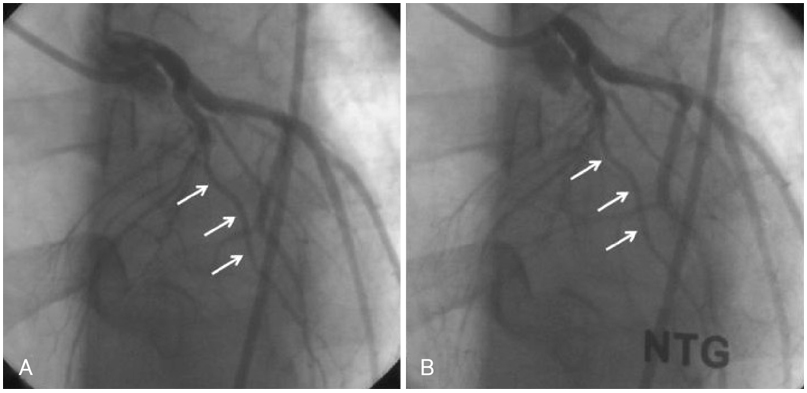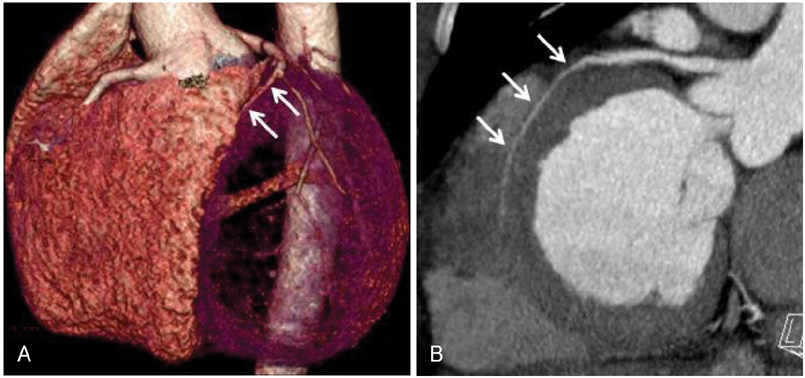Korean Circ J.
2009 Apr;39(4):163-167. 10.4070/kcj.2009.39.4.163.
Myocardial Infarction in a Young Man due to a Hypoplastic Coronary Artery
- Affiliations
-
- 1The Heart Center of Chonnam National University Hospital, Cardiovascular Research Institute of Chonnam National University, Gwangju, Korea. myungho@chollian.net
- KMID: 2225692
- DOI: http://doi.org/10.4070/kcj.2009.39.4.163
Abstract
- Hypoplastic coronary artery disease (HCAD) is a rare condition that may lead to myocardial infarction (MI) and sudden death. We discovered HCAD in a young man who developed chest pain after heavy drinking and who was found to have suffered an MI. His ECG showed ST-segment elevation with Q waves in the anterior leads, and echocardiography revealed apical dyskinesia with moderate left ventricular (LV) dysfunction. Coronary angiography showed hypoplasia of the left anterior descending (LAD) artery. (99m)Tc-tetrofosmin-gated myocardial perfusion scintigraphy showed a large, fixed perfusion defect in the anteroseptal and apical segments. Sixty-four-slice cardiac CT and cardiac MR imaging demonstrated thinning of the apical wall with calcification and delayed enhancement, supporting the diagnosis of long-standing MI. The patient was discharged symptom-free on medication for ischemic heart failure two weeks after admission. Although HCAD is very uncommon, it should be considered in children and young adults who suffer MI or sudden cardiac death.
MeSH Terms
Figure
Reference
-
1. Roberts WC, Glick BN. Congenital hypoplasia of both right and left circumflex coronary arteries. Am J Cardiol. 1992. 70:121–123.2. Zugibe FT, Zugibe FT Jr, Costello JT, Breithaupt MK. Hypoplastic coronary artery disease within the spectrum of sudden unexpected death in young and middle age adults. Am J Forensic Med Pathol. 1993. 14:276–283.3. Kim MS, Han JK, Lee SE, et al. Cases of right ventricular myocardial infarction in patients with an absent or hypoplastic right coronary artery. Korean Circ J. 2007. 37:84–86.4. Amabile N, Fraisse A, Quilici J. Hypoplastic coronary artery disease: report of one case. Heart. 2005. 91:e12.5. Lipsett J, Cohle SD, Berry PJ, Russell G, Byard RW. Anomalous coronary arteries: a multicenter pediatric autopsy study. Pediatr Pathol. 1994. 14:287–300.6. Göl MK, Ozatik MA, Kunt A, et al. Coronary anomalies in adult patients. Med Sci Monit. 2002. 8:CR636–CR641.7. Casta A. Hypoplasia of the left coronary artery complicated by reversible myocardial ischemia in a newborn. Am Heart J. 1987. 114:1238–1241.8. Angelini P, Velasco JA, Flamm S. Coronary anomalies: incidence, pathophysiology and clinical relevance. Circulation. 2002. 105:2449–2454.9. Maron B, Roberts WC. Akhtar M, Myerburg RJ, Ruskin JN, editors. Causes and implications of sudden cardiac death in athletes. Sudden Cardiac Death. 1994. Philadelphia: Williams & Wilkins;238–255.10. Virmani R, Burke AP, Farb A. Williams RA, editor. The pathology of sudden cardiac death in athletes. The Athlete and Heart Disease. 2000. Philadelphia: Lippincott Williams & Wilkins;249–272.11. Maron BJ, Shirani J, Poliac LC, Mathenge R, Roberts WC, Mueller FO. Sudden death in young competitive athletes: clinical, demographic, and pathological profiles. JAMA. 1996. 276:199–204.12. Waller BF. Wenger NK, editor. Exercise-related sudden death in young (age ≤30 years) and old (age ≥30 years) conditioned subjects. Exercise and the Heart. 1985. 2nd ed. Philadelphia: FA Davis;9–73.13. Basso C, Maron BJ, Corrado D, Thiene G. Clinical profile of congenital coronary anomalies with origin from the wrong aortic sinus leading to sudden death in young competitive athletes. J Am Coll Cardiol. 2000. 35:1493–1501.14. Cheitlin MD . Estes NA, Salem DN, Wang PJ, editors. Coronary anomalies as a cause of sudden death in athletes. Sudden Cardiac Death in the Athlete. 1998. Armonk, NY: Futura Publishing Company;379–391.15. Blake HA, Mahion WC, Mattingly TW, et al. Coronary artery anomalies. Circulation. 1964. 30:927–934.16. Gradaus R, Wollman C, Kobe J, et al. Potential benefit from implantable cardioverter-defibrillator therapy in children and young adolescents. Heart. 2004. 90:328–329.17. Buxton AE, Lee KL, Fisher JD, Josephson M, Prystowsky EN, Hafley G. A randomized study of the prevention of sudden death in patients with coronary artery disease. N Engl J Med. 1999. 341:1882–1890.18. Moss AJ, Hall WJ, Cannom DS, et al. Improved survival with an implanted defibrillator in patients with coronary disease at high risk for ventricular arrhythmia. N Engl J Med. 1996. 335:1933–1940.
- Full Text Links
- Actions
-
Cited
- CITED
-
- Close
- Share
- Similar articles
-
- Cases of Right Ventricular Myocardial Infarction in Patients with an Absent or Hypoplastic Right Coronary Artery
- Coronary-Pulmonary Fistulas Involving All Three Major Coronary Arteries Co-Existing With Myocardial Infarction
- Acute Myocardial Infarction in Patient with Spontaneous Coronary
- Acute myocardial infarction in young patient probably due to Kawasaki disease
- Right Ventricular Myocardial Infarction due to Right Coronary Artery Total Occlusion Originating From the Distal Left Circumflex Artery









